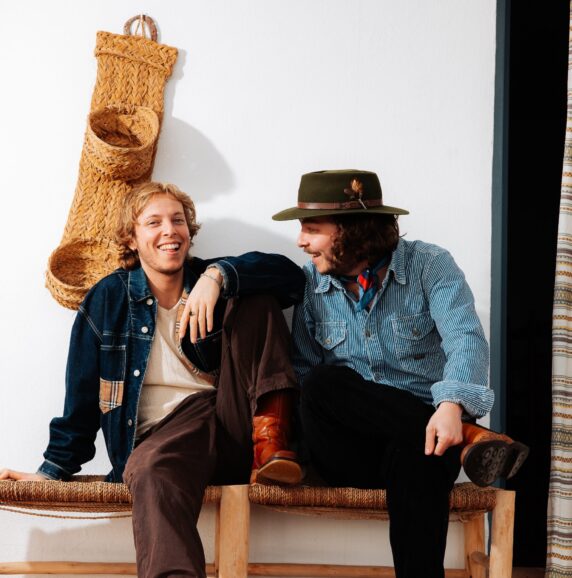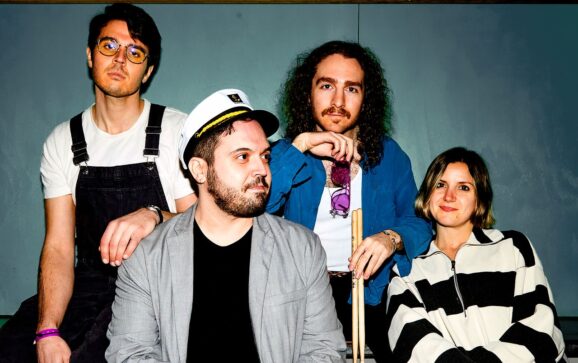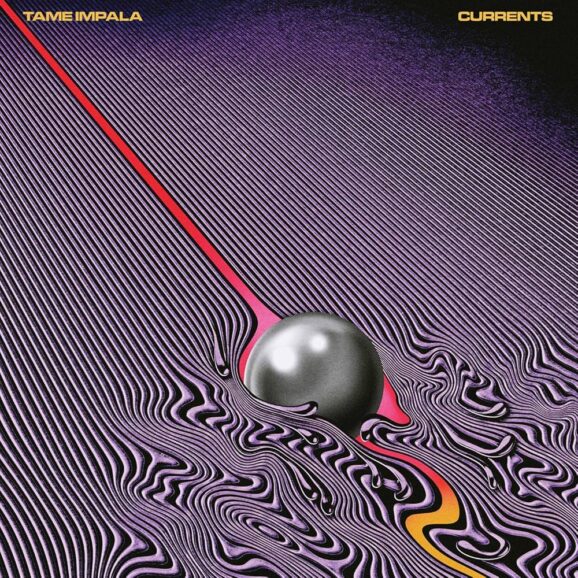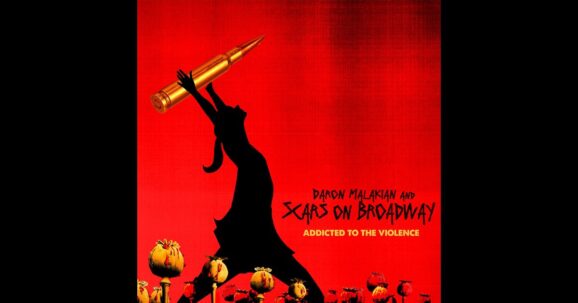It wasn’t supposed to be the seminal punk rock club that it ultimately became. Hilly Kristal never intended to change the face of rock history when he opened his dingy club in New York City’s East Village in the winter of ’73. No, he just wanted to have a place that featured the kind of music he liked – Country, Bluegrass, Blues – which is of course why he named it CBGB.
But just a few short weeks after opening the doors, Hilly would find himself immersed in a fledging scene looking for a home. In New York in the early 70’s, the few clubs that even featured live bands rarely took to booking originals. It was a much better draw showcasing a cover act, though Hilly didn’t see it that way. In contrast, he made it a club policy to only book original music, forcing bands playing his stage to give it everything they had night after night to earn a little respect from the overtly gnarly crowd. Well, he was on the Bowery, right underneath a flophouse, so the crowds did tend to be a little rough, which from a club owners perspective can have its pros and cons. You’re not exactly pouring martinis for the theatre crowd, but young rockers didn’t seem to mind stepping over rats and winos at 3am for a bottle of warm beer. So it didn’t take long for CBGB to become THE place for gritty rock in the 70’s.
Things moved pretty quickly the first few years, and punk rock was thriving. Although the club wasn’t exactly profitable, by ’76 CBGB had the best rock and roll sound system in NYC. It would take Hilly ten years to pay for it, but that move allowed him to offer his loyal patrons the best rock show they could get from a bar stool a few feet away, while the bands ate it up. Unsigned, unproven acts could tear through unknown sets on a crystalline system they couldn’t get the privilege to play anywhere else. And as they gained followings, the labels and record execs started coming too, even asking Hilly to try out new acts because they knew they’d sound loud, combustible and full of life.

The 80’s and 90’s saw CBGB expand into a gallery, later becoming a promoter of the local art scene and soon developing a solid foundation in an ever-changing neighborhood. Have you looked for an apartment in the Village lately? Try renting out the entire bottom of a building and generating your income on starving artists and well drinks. It’s definitely not the real estate market it was thirty years ago. The club is in conflict with its landlord, the Bowery Residents Committee, over back rent and an increase to the monthly rental cost, which is about $19,000. The lease expires on August, 31, 2005. It’s a typical his word against mine, good tenant, bad tenant battle and its not looking good.
So as the city prepares for a last minute fundraising concert later this month in Washington Square Park, we sat down with Hilly in his cramped and dark office. He looks and speaks like an old Sea Captain – someone you only read about, who’s seen more than you’ll ever know. And he’s busier than ever right now, getting ten minutes with us between an interview with NPR and a meeting with Steven Van Zandt. Yeah, its just a rock club, and the heyday is gone, but its also the birthplace of punk, and it would be nice to keep the trademark awning and legendary rock club preserved…even if you have to walk over a wino to get there.
How did CBGB’s originally come to open it’s doors in ‘73?
I was over in the West Village, I had a club there along with [the other clubs] Reno Sweeney, Bells of Hell, and the people on the block didn’t want cabaret of any sort. I had country, bluegrass, blues going there. And I had the lease here [on Bowery] from before, when I started an artist bar, and I just came over and decided to do it here. I said ‘the hell with this,’ so I sold it…they didn’t pay me, but I sold it. Unfortunately, I had to get it back again. So I started this basically…I took it over in December, so I had the whole Christmas, New Years thing, and then we got down to serious business of getting bands in…and that’s how I opened it. I kind of redecorated a little bit, but it was pretty much the same as the way I had left it when I had it before.
As the club grew in the ’70s, were you aware at all of the significance the club and the music would eventually have?
Well, I didn’t do it for that reason. People may be aware of different things, and you have to take it with a grain of salt. Bands eventually came, we started doing country, bluegrass-blues country music, folk country music, not Nashville country. [And then] it was some jazz…and I had a couple of rock bands, but then Terry Ork came and pushed Television on me, and the Ramones and all those fateful Sundays…and things started jelling on those Sundays. Well not jelling, I mean the rent was $700 a month, so I supported it…I slept in the back so I didn’t have to pay rent any place except for here.
And it was finding those groups that had no place to play their own music. I don’t think any club let you play a lot of your own music unless you were know, had a recording contract or something, this is what I found among these rock bands that were just playing the basements, lofts, stuff like that. And there were a lot of them around. They started coming around and I started putting more of them in, there was a whole slew of them. And I saw there were so many during the summer of ‘74, so I thought – [Max’s Kansas City] wasn’t open, one owner had sold to the other so they were closed – so I just decided I was going to do something that I wish had been done for me when I was a singer…I was gonna have a place that they can play, grow and develop, but my criteria no matter how well they played or how poorly they played, it had to be their own thing. To me, that’s what I felt was the most important thing. And so I demanded they write their own music, and that kind of turned things on.
Aside from the obvious real estate development, how has the neighborhood changed in the past 30 years?
Well the whole scene has changed in New York, but thank heavens its getting nicer. There are a lot of things around, and I think its good, its very healthy, it’s a mixture. When you think 4th Street, 3rd Street, Great Jones, all the way down, its an interesting mixture of people that live within a block or two or three of the Bowery. The East Village has changed, the Lower East Side has changed…its forever changing. Its not the same. Is it exciting? Well, when you first start something, that’s exciting. For a number of years, its hard work, very hard, but its exciting. So its not as exciting to me now, but its certainly interesting.
What is the current lease situation?
Well these people want to double my rent. It’s a not-for-profit organization, but the BCR gets, from the city, state, federal government, they got 30 million dollars last year. They’re doing well, but they want my rent…instead of $250,000 a year, they want $500, $600, $700,000 a year. So they want 250, 300 more…I don’t see, you know, its 1% of what they get for nothing, and I feel, in our case, we’ve contributed to New York, and to the scene of rock and roll. We’ve had tens of thousands of musicians play here…some have gotten great contracts, and some are in the Hall of Fame. We’ve had a lot of artists do shows [at the gallery]. The gallery is really very useful. We’ve have poetry, a lot of theatre. And I think New York is proud of us, the city. I think in this case, we just can’t pay double. We just can’t. Its not that kind of a place.
Have you discussed historical grants as a possibility?
Well were in the process of having the place landmarked. I don’t know how much that will help.
How is the city getting involved?
I don’t know, you tell me…get them involved…I’d love to have them involved. No, I think they are, probably in ways I don’t know. Nobody’s been in touch with me. Little Steven’s organization, Steven Van Zandt has been helping quite a bit.
And I don’t owe the landlord any money. I don’t care what he said, I don’t owe him anything. There’s a dispute over money that’s in court, and [its up to a judge to] decide that it be paid, whatever she says, if I [have to] pay anything. So its up to a judge.
Landmark CBGB Bands
Television – Although they were virtually ignored by the mainstream and sold less records than they care to remember, Television was punk’s version of The Grateful Dead. Lead guitarist and main songwriter Tom Verlaine and rhythm guitarist Richard Lloyd brought infectious jamming to a new level unheard of outside the psychedelic scene in the 70’s. Their 1977 debut Marquee Moon is about as prominent, yet unheralded on any critics top 100 album list as a Nick Drake recording.
Blondie – By 1976, Blondie was appearing regularly at CBGB and by the end of the 70’s, the Debbie Harry led outfit became the most commercially successful band of the New York punk scene. They clearly went pop, and the band broke up in 1982, but their short lived influence can be heard at any bar on a Saturday night as “Heart of Glass,” “Call Me” and “Tide Is High” are jukebox heros.
Talking Heads – The orchestrated funk and new wave rockers first began as a three piece at CBGB in 1975. Although they were never conventionally punk, the band soon found mainstream success with their cover of Al Green’s “Take Me to the River.” Forming the most danceable music to emerge from the New York scene, the band went on to lay a historic pillar of albums and one landmark concert film.
Ramones – The godfathers of punk, no band helped define punk rock in New York more than this Queens four-piece. With simple chords and riffs played over breakneck speeds The Ramones were as exciting, dirty and lethal as anything going on in New York in the 70’s that didn’t have to do with Travis Bickle or Son of Sam. Performing 20 minute sets of two minute songs, their leather jackets and shaggy cuts soon became the work of legends with such cuts as “Blitzkrieg Pop,” “Beat On The Brat,” and “I Wanna Be Sedated.” The question now is, what black t-shirt is more legendary – The Ramones or CBGBs?
Patti Smith – “Three chord rock mixed with the power of word,” was laid forth by none other than Patti Smith. The long faced female version of Mick Jagger helped put CBGB on the map as she joined forces with rock writer Lenny Kaye and played CBGB for eight weeks in the spring of 1975 and grabbed the attention of Clive Davis. A few years later she grabbed her first top 20 hit with “Because The Night.”
Other Noteworthy Artists That Have Played CBGBs
AC/DC, Agnostic Front, Anthrax, The B-52s , Bad Brains, Bad Religion, Bush, Butthole Surfers, David Byrne, John Cale, Cheap Trick, Circle Jerks, Cowboy Junkies, The Cramps, Crowded House, D Generation, The Damned, Dashboard Confessional, The Dead Boys, The Dictators, Dinosaur Jr., Drivin N-Cryin, The Egyptians, Elvis Costello, Everclear, Eraser, Marianne Faithfull, Fastball, Fishbone, Girls Against Boys, Goo Goo Dolls, Guns N’ Roses, PJ Harvey, Richard Hell and the Voivods, Helmet, Hole, Alan Jackson, The Jam, Jawbox, The Jesus Lizard, Joan Jett, Korn, Lemonheads, Ted Leo & the Pharmacists, The Libertines, Live, Living Colour, G Love & Special Sauce, Luna, Dave Matthews Band, Meat Puppets, Mudhoney, New Found Glory, Pavement, Pearl Jam, Liz Phair, Phantom Planet, Plasmatics, The Police, Psychedelic Furs, Rancid, Lou Reed, The Replacements, Rocket from the Crypt, Rollins Band, Rooney, The Runaways, Screamin’ Jay Hawkins, The Shirts, Sleater-Kinney, Smashing Pumpkins, Sonic Youth, Social Distortion, Soul Asylum, Soul Coughing, Spacehog, Jon Spencers Blues Explosion, Spinal Tap, Bruce Springsteen, The Strokes, Suicide, Sum 41, Teenage Fanclub, Tom Tom Club, The Vines, X-ray Spex, XTC, White Zombie, Yo La Tengo
Much thanks to the recent book CBGB & OMFUG, Thirty Years from the Home of Underground Rock for the pictures and to Hilly Kristal.
For more information on the club and its current situation, please visit Save CBGB’s or littlesteven.com












